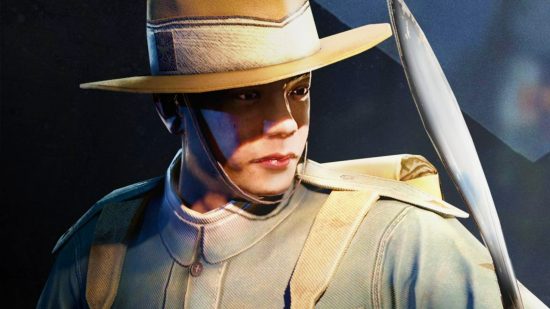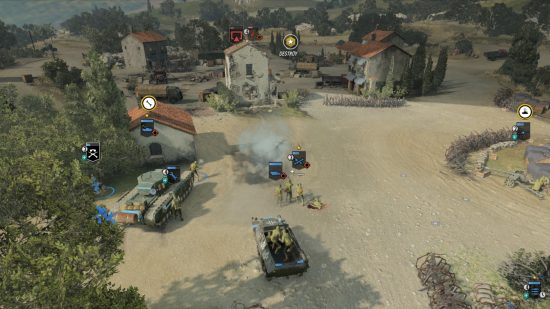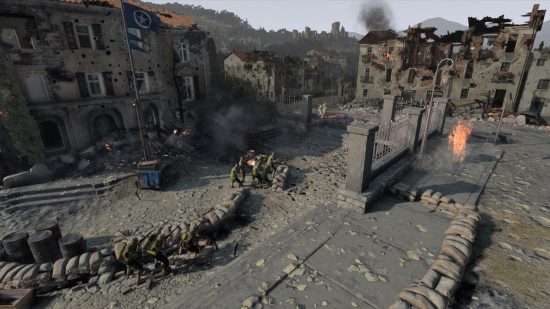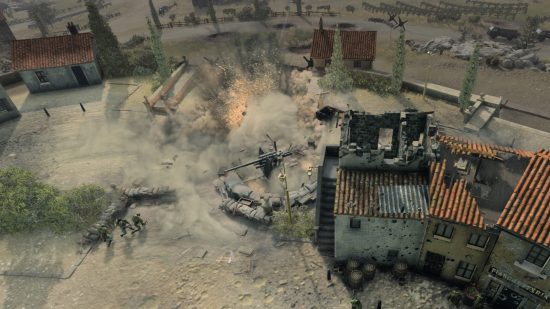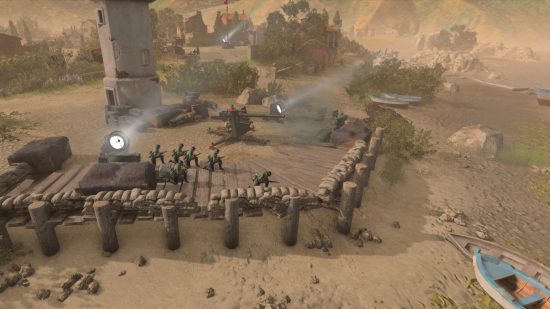Our Verdict
The classic RTS battles carry the third entry in this once-essential series, returning more or less untouched, but alongside a bloated and unfinished campaign mode that feels at odds with the core ideas of Company of Heroes.
With the frozen forests of Ardennes Assault now eight years gone, I was excited to start work on our Company of Heroes 3 review. On paper, the concept was rock solid: take the non-linear campaign added to the RTS game series in that fantastic expansion for Company of Heroes 2 and broaden it to encompass all of southern Italy. While the battles still retain Relic’s singular knack for interesting maps and dynamic squad-based combat, the single-player Italy campaign map is a mess, bogged down with half-formed ideas that make the campaign a confusing, repetitive, and frustrating experience.
Company of Heroes 3’s Italy campaign puts you in charge of the joint Allied invasion, a combined expedition of British and American forces that finds support in the local Italian partisans. After a brief tutorial segment in Sicily, everyone boards a ship to make a beachhead on the Italian mainland, ultimately linking up with friendly seaports on the Adriatic coast and pushing north to Rome.

However, where Ardennes Assault was a constrained map set in the dense wintry forests along the border between France and Belgium, Company of Heroes 3’s main campaign covers almost the entirety of Italy south of the 42nd parallel north, split up into dozens of territories. Control of these territories grants resources and access to base facilities like airports, naval docks, and hospitals.
By securing seaports and runways, I’m able to purchase new ‘companies’ to field in Italy. There are a few varieties: US paratroopers, special forces, and armour; British infantry and support, as well as Indian auxiliary artillery. The company type determines the deck of units and special abilities that are available when the real-time battles break out, and each unit gradually unlocks additional abilities and more specialised units – such as heavy tanks and devastating close air support strikes – as they gain veterancy in combat.
The real-time tactical combat is just as I remember it from Company of Heroes 2. In the campaign’s many skirmishes, I quickly send out infantry and scout squads to capture map nodes until I cross paths with German forces, at which point I zoom in to micromanage my troops under fire by commanding them to take cover and hurl grenades. Snipers can take positions in towers, and soldiers can take shelter in buildings, firing out at Wehrmacht forces from the windows.
The set-piece missions are, naturally, the highlight of the campaign. They’re the summer blockbuster sequences: not technically challenging, but dramatic and bombastic, and the rugged Italian countryside provides a perfect backdrop for daring raids into fortified mountain redoubts and tank battles across rustic town plazas. Masonry and roofing tiles shake loose from buildings when infantry squads lob in grenades to flush out snipers or machine gun nests, and soldiers run to take cover alongside the smouldering hulks of bombed-out tanks.
Unlockable and upgradeable special abilities dial up the Hollywood factor: there’s the thrilling buzz of propellers as Spitfires make strafing and dive-bombing runs, and off-map artillery barrages send up geysers of earth and fire as they thump their target areas.
The push north to Rome climaxes with the Battle of Monte Cassino, a historic attack on the anchor of the Gustav Line, which largely held Allied forces out of northern Italy between December 1943 and June 1944. The battle itself is classic Company of Heroes: I send my infantry and airborne troops into the small town at the bottom of the hill to secure a foothold at the town hall before sending squads to clear Germans out of a nearby hotel and search for local partisans. Then it’s up the switchbacks of the mountain road that leads to the Benedictine abbey, weathering heavy artillery fire the whole way.
The central story missions don’t do a lot to innovate on what Company of Heroes 2 established almost a decade ago, but they’re a hell of a lot of fun, and they unfold on a series of increasingly stunning maps. Strung together in a traditional RTS campaign, these would make a perfectly solid entry in series. Instead, Relic has placed them on a Total War-style campaign map that spreads the action out across a somewhat nonsensical and largely boring ‘strategic’ layer that feels like it’s missing crucial elements.
Some of the Italy campaign’s issues are minor annoyances, like low-res artwork in certain menus or redundant barks (every turn!) from the US general urging me to take out the rail-based artillery gun up in Anzio. A larger problem is the German AI, which never really pushes back against any of my moves to capture territory. German companies will occasionally attack mine, but the computer makes no attempt to recapture cities I’ve liberated, which trivialises the whole affair. I can send my companies wherever I like, making this feel more like Heroes of Might and Magic than a traditional wargame, or even a Total War campaign.
The Italy campaign also does a poor job of communicating strategic goals. NPC advisers provide competing priorities, but certain missions – such as the assault on Monte Cassino – have conditions that must be met before they can be attempted. A list in the upper-left corner of the screen provides a simplified view of the most recent missions on offer, but no detailed breakdown of what needs to be done in order to complete the multi-phase objectives.
The upshot is that missions like Monte Cassino are present on the map, but will be artificially locked when a unit approaches. Only when I had a unit near the town could I click the nameplate and find a list of steps I needed to take before I was allowed to launch the mission itself. It’s frustrating, and has required me to reload old saves on several occasions because I wasn’t aware of what I needed to plan for.
A population cap mechanic limits the number of units you can field at a time, and the only way to raise it is to capture seaports. That keeps very much at all from happening in the opening turns, and once things are up and running, there’s a lot of countryside to wander around where nothing much is going on. Buttons aren’t clearly labelled, and the processes for sending troops around via air or sea are fussy and time-consuming to use.
None of this applies to the Deutsche Afrika Korps ‘operation’ that’s also available in single-player. This plays much more like a traditional Company of Heroes campaign; it’s a string of scenarios linked in fixed narrative order, covering Erwin Rommel’s stint as ‘The Desert Fox’ in occupied Libya.
The Italy campaign is the main event, though, and it’s not an experience I can recommend in its current state. It’s missing some things that would be easy to fix: a complete UI/UX, with additional information about current mission objectives is one glaring example. Giving the Germans a fiercer campaign map presence would also go a long way toward justifying its open sandbox format.
As it stands now, though, the campaign is mostly filler – there’s still a specific order in which the major missions must be attempted, and that directly conflicts with the sprawling map that looks prime for creative strategic decision-making, but is not. There’s just not enough to actually do to support all the different structures, logistical mechanics, and provinces Company of Heroes 3 throws at you.
Yet, as much as I’ve complained about the campaign, the battles – both in single-player and multiplayer, which remains as gripping as ever – are still the Company of Heroes I fondly remember. Not much here has changed, and perhaps the under-cooked Italian campaign exists alongside it because Relic felt it had to introduce a new feature in order to sell us a new entry in the series. It really didn’t – and those classic, action-packed battles are among the series’ finest. Those are what kept me trudging around the hills of Campagnia on my way to Rome.
